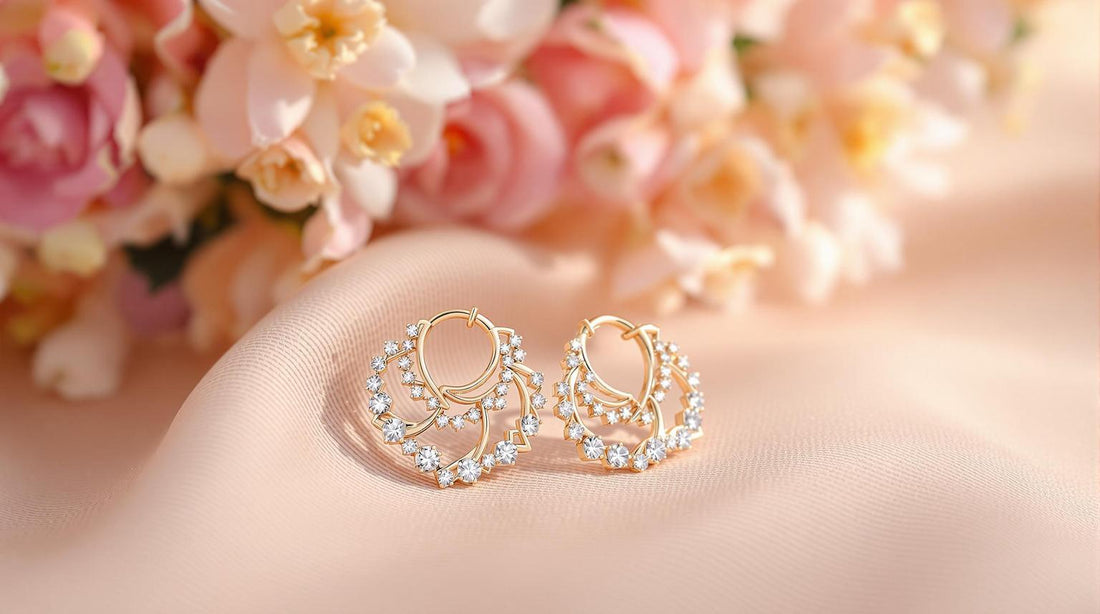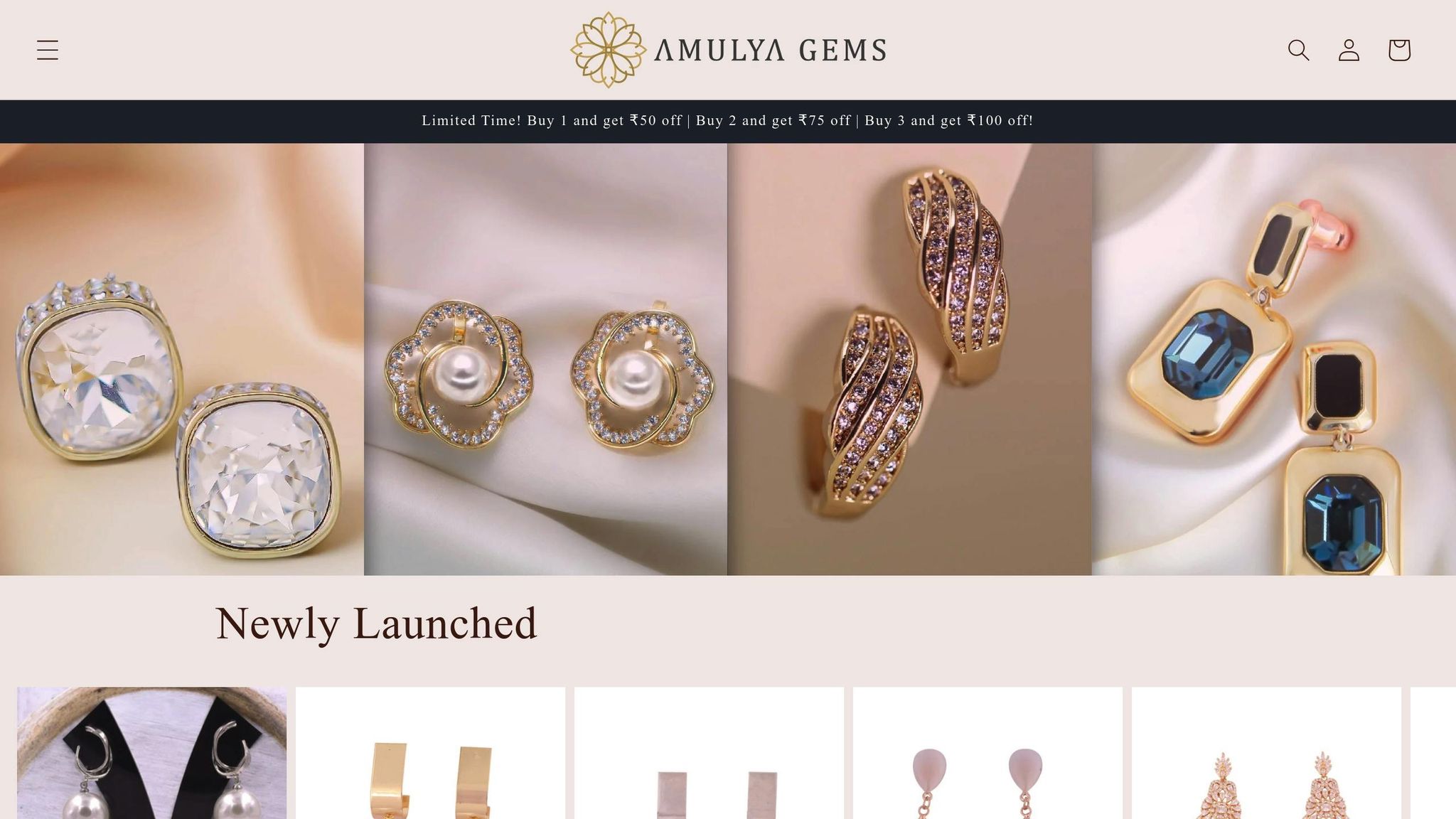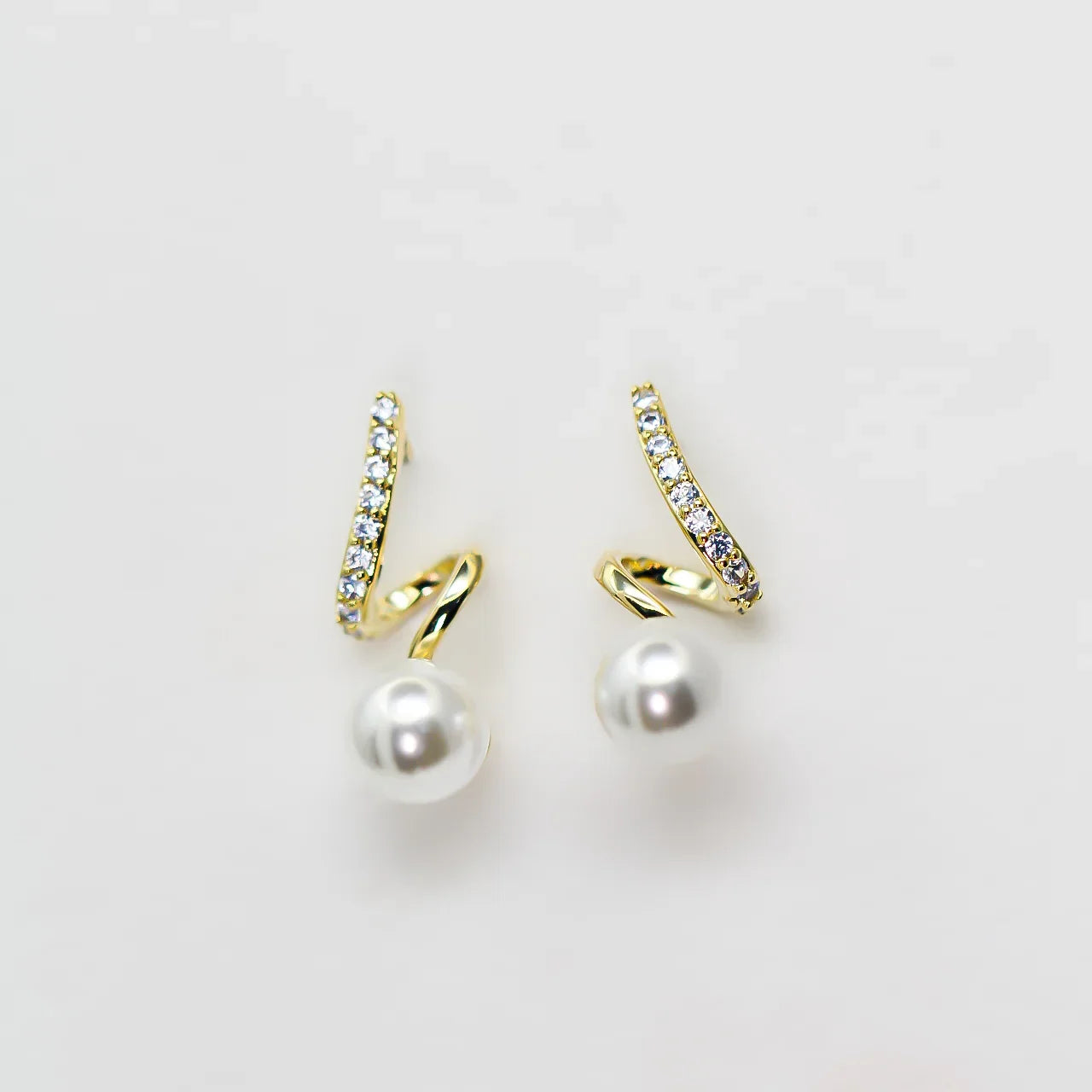
Common Earring Allergies: Solutions and Prevention Tips
Share
Sensitive ears? Earring allergies are more common than you think. They’re often caused by metals like nickel, leading to redness, itching, and swelling. Here’s a quick guide to avoid discomfort and keep your ears happy:
- Top Causes: Nickel is the biggest culprit, but cobalt, brass, and low-karat gold can also trigger reactions.
- Safe Materials: Opt for titanium, surgical-grade stainless steel, 14k+ gold, pure platinum, or medical-grade plastic.
- Prevention Tips: Regularly clean earrings, patch-test new ones, and avoid gold-plated or cheap fashion jewelry.
- Treatment: Remove earrings, clean the area, and use hydrocortisone cream or antihistamines for relief.
Quick Comparison of Safe Materials:
| Material | Allergy Risk | Cost | Durability | Best For |
|---|---|---|---|---|
| Titanium | Extremely Low | High | Excellent | Severe sensitivities |
| Surgical Steel | Low | Affordable | Good | Daily wear |
| 14k+ Gold | Low | High | Good | Regular wear |
| Medical-Grade Plastic | Very Low | Moderate | Moderate | New piercings |
| Sterling Silver (925) | Moderate | Moderate | Moderate | Occasional wear |
Avoid discomfort by choosing the right materials and practicing good care habits. Read on for detailed tips on prevention, treatment, and where to find affordable, safe earrings.
Nickel Allergy - Best Metals For Sensitive Ears
Problem Materials in Earrings
Choosing safer earrings starts with understanding the metals that often cause allergic reactions. Let’s break down the common culprits.
Nickel Allergies
Nickel is the most common cause of jewelry-related allergies worldwide. According to the Mayo Clinic, it’s a major trigger of allergic dermatitis. As one of the most widely used metal alloys, nickel frequently shows up in jewelry, especially in budget-friendly options.
Here’s where nickel is often found:
- White gold (plated with rhodium, which wears off over time)
- Silver-plated pieces
- Cost-effective fashion jewelry
Its prevalence makes it tricky to avoid, even for those trying to steer clear of allergens.
Other Metal Allergies
Nickel isn’t the only metal that can cause issues. Several other metals commonly used in earrings can also trigger reactions:
| Metal Type | Common Uses | Potential Issues |
|---|---|---|
| Cobalt | Jewelry alloys | Can cause reactions similar to nickel |
| Brass | Costume jewelry | Contains copper and zinc, may irritate skin |
| Gold-plated metals | Affordable jewelry | Base metals exposed when plating wears off |
Even supposedly "safe" metals can be problematic. For example, sterling silver (92.5% pure silver) often contains copper and may have trace amounts of nickel. Gold under 18 karats is typically mixed with other metals that could trigger allergic reactions.
Visual inspection won’t tell you if a piece contains allergenic metals. To play it safe, assume any metal jewelry includes nickel unless it’s specifically labeled as:
- Stainless steel
- 18- or 24-karat gold
- Pure platinum
- Sterling silver (though some people may still react)
Be cautious with items marked "hypoallergenic." This term isn’t strictly regulated in the jewelry industry. For extra peace of mind, consider using a metal testing kit - available at pharmacies or through dermatologists - to check for potential irritants before wearing new earrings.
Knowing these risks can help guide you toward safer, skin-friendly options.
Safe Materials for Sensitive Ears
When choosing earrings for sensitive ears, it's important to focus on materials that minimize the risk of irritation or allergic reactions. Here are some reliable options for comfortable, allergy-free wear.
Comparing Steel and Titanium
Surgical-grade stainless steel and titanium stand out as excellent choices for sensitive ears, each offering unique advantages.
Surgical-grade stainless steel contains at least 13% chromium, making it highly resistant to corrosion compared to standard stainless steel, which usually has 10.5% chromium. Its smooth, nonporous surface reduces bacteria buildup and is easy to clean. However, it can contain up to 12% nickel, which may cause issues for those with severe sensitivities.
Titanium, on the other hand, is known for being biocompatible and completely nickel-free. Fewer than 0.6% of people report allergic reactions to titanium. It's also lightweight yet incredibly strong, making it a practical choice for daily wear.
Here's a quick comparison of these two materials:
| Feature | Surgical Steel | Titanium |
|---|---|---|
| Weight | Heavier | Lightweight and more comfortable |
| Corrosion Resistance | Good | Excellent |
| Cost | Budget-friendly | More expensive |
| Color Options | Silver metallic only | Can be anodized in various colors |
| Allergy Risk | Low, but contains nickel | Extremely low, nickel-free |
For those with severe allergies, non-metal options might be a better solution.
Non-Metal Alternatives
Non-metal earrings offer a safe and stylish option for sensitive ears.
Natural Materials
Earrings made from wood, stone, or glass are great for reducing allergy risks. However, always check the fastening mechanism, as many non-metal earrings still use metal posts or hooks that touch your skin.
Synthetic Options
High-quality plastic earrings provide a completely metal-free alternative. They're ideal for active lifestyles, water-based activities, and even during the healing process after a new piercing.
When opting for non-metal earrings, it's crucial to confirm that the backing material is also free of problematic metals, as even hypoallergenic options can sometimes cause reactions if the fasteners contain allergens.
sbb-itb-1e688ee
How to Treat Earring Allergies
If preventive measures don’t work and an allergic reaction occurs, acting quickly can help ease the discomfort.
Quick Relief Steps
Start by removing the earrings and cleaning the area with a saline solution. Then, try these steps:
- Cool compress: Use a clean, damp cloth to reduce swelling.
- Hydrocortisone cream: Apply 1% hydrocortisone cream to calm inflammation.
- Oral antihistamines: Medications like Benadryl or Zyrtec can help reduce itching and swelling.
- Natural options: Soothe the skin with calamine lotion, petroleum jelly, or mineral oil.
Treatment can include:
- Topical solutions: 1% hydrocortisone cream to reduce inflammation.
- Oral medications: Antihistamines for broader relief.
- Skin protectants: Calamine lotion or petroleum jelly to moisturize and shield the skin.
These steps, combined with preventive care, can provide relief and help the skin heal.
When to See a Doctor
Contact a doctor if you notice any of the following:
- Severe or worsening pain.
- Pus coming from the piercing site.
- Redness spreading beyond the affected area.
- Symptoms lasting more than a week after removing the earrings.
A doctor might recommend stronger treatments, such as prescription corticosteroid creams, nonsteroidal anti-inflammatory drugs, or even phototherapy for stubborn cases.
Keep the area dry and clean, and avoid using over-the-counter antibiotic creams unless directed by a doctor, as they could worsen the reaction. Wait until the allergy has completely cleared before wearing earrings again.
How to Prevent Allergic Reactions
Preventing allergic reactions involves smart material choices, proper cleaning habits, and careful testing of new earrings.
Choosing Safe Earrings
Opt for earrings made from:
- 14k gold or higher
- Sterling silver 925
- Titanium
- Medical-grade plastic
- Niobium or platinum
"Your best choices for nickel-free, hypoallergenic materials in jewelry are titanium and medical grade plastic. They are both versatile, durable and comfortable to wear."
Steer clear of gold-plated earrings, as they may contain nickel. The American Academy of Pediatrics highlights that around 11 million children in the U.S. experience nickel-allergic contact dermatitis, making the right material choice crucial.
Cleaning Your Earrings
"It's important to remove and clean your earrings regularly to prevent overgrowth of sweat, oil, dirt, and microorganisms",
Clean your earrings weekly using mild soap, warm water, and an alcohol swab. Ensure they are completely dry before storing them in a clean jewelry box. This routine helps prevent infections and reduces the risk of recurring allergic reactions.
Testing New Earrings
Before wearing new earrings full-time, perform a patch test. Hold the earring against your wrist for a few minutes. If no irritation occurs, wear it for 2–3 hours and check for any delayed reactions.
| Material Type | Safety Level | Best For |
|---|---|---|
| Medical Grade Titanium | Highest | Extremely sensitive skin |
| Medical Grade Plastic | Very High | New piercings |
| 14k+ Gold | High | Regular wear |
| Sterling Silver 925 | Moderate-High | Occasional wear |
Where to Buy Safe, Affordable Earrings
Looking for budget-friendly earrings that won't irritate your skin? You don’t have to sacrifice quality for affordability. Choosing hypoallergenic earrings from reliable sources is key to avoiding allergic reactions.
Amulya Gems Collections

Amulya Gems features a range of hypoallergenic earrings crafted from skin-friendly materials. Their collection includes everything from elegant studs to eye-catching chandeliers, blending classic and modern styles. Prices range from $15.99 to $29.99, making them an accessible option for safe and stylish jewelry.
Other Affordable Options
Several well-known brands also offer hypoallergenic earrings at reasonable prices. Here are a few to consider:
| Brand | Price Range | Materials | Best For |
|---|---|---|---|
| Blomdahl USA | $25.00 - $70.00 | Medical-grade titanium, plastic | New piercings |
| Desert Peach | $13.00 - $22.00 | Surgical steel | Daily wear |
| Sensitively Yours | $21.95 | Surgical steel | Long-term use |
| Serenity Jewellery | $11.00 - $22.00 | Titanium, steel | Budget options |
One happy customer shared their experience with Desert Peach: "I have the world's most sensitive ears and these earrings work perfectly. It feels like I'm not even wearing any." This highlights the comfort and reliability of their flat-back studs.
When shopping for hypoallergenic earrings, keep an eye out for:
- Material certifications to ensure they're genuinely hypoallergenic.
- Detailed material descriptions to avoid potential irritants.
- Return policies that address allergic reactions.
- Customer reviews from people with sensitive skin.
Many of these brands also offer discounts for bulk purchases or during seasonal sales, making it easier to find safe, affordable earrings that suit your style and needs.
Conclusion
Having sensitive ears doesn't mean you have to compromise on style. By choosing the right materials and practicing good care habits, you can enjoy wearing earrings without worrying about allergic reactions.
Be cautious - just because earrings are labeled "hypoallergenic" doesn't mean they're completely safe. Look for clear product documentation and stick to proven materials like medical-grade titanium or plastic. Always double-check that the materials are certified before making a purchase to ensure your comfort and safety.
Keeping your earrings clean and storing them properly can also make a big difference. A simple maintenance routine not only protects your ears but also helps your jewelry last longer.
If you have a nickel allergy, avoid stainless steel, as it often contains 8–12% nickel. Titanium is a better option. While it may cost more upfront, its durability and nickel-free properties make it worth the investment.

